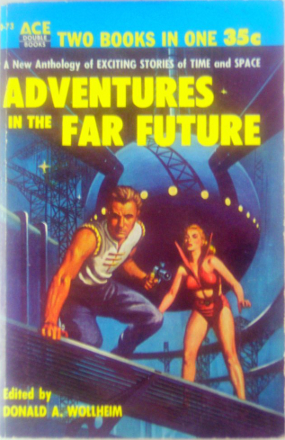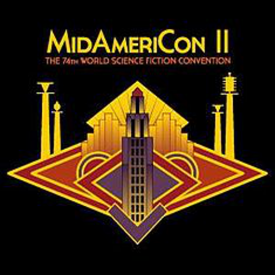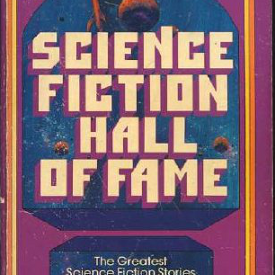 One of the handicaps of being devoted to childhood nostalgia (in SF terms) is that you can go through your fannish life remembering something you thoroughly enjoyed, or at least remember that it had a huge impact on you back in the day, yet can’t remember enough details to identify what the memory is all about.
One of the handicaps of being devoted to childhood nostalgia (in SF terms) is that you can go through your fannish life remembering something you thoroughly enjoyed, or at least remember that it had a huge impact on you back in the day, yet can’t remember enough details to identify what the memory is all about.
Case in point, a short story about a spaceship entering another dimension in order to go from point A to point B without travelling the distance in-between. Possibly it was termed “going into hyperdrive,” possibly something else.
I remember simply that the spacecraft was trapped in ever shifting vistas of rippling space that was something like an Aurora Borealis, except that every colour was black, and the stars rippled among the folds as if buried deep amid waves of darkness. Blew my mind that did.
And the ending. I remember the ending. Turned out the spaceship was inside the guts of a worm.
But I could never remember the title of the story. Or the name of the author. Or where and when it was published.
I just know I read it when I was a kid. Probably in a pocketbook anthology.
So anyway, walking down a hall at VCON 38 and passing along the lineup of people waiting to get into the costume contest, Jeff Hartt ( a prominent member of the Arch Duchy of Connacht Adrian Empire Medieval Re-enactment Society, and whose name I can never remember whether is spelled with one ‘t’ or two – so I compromised and spelled it both ways in the VCON program book – did I mention my legendary attention to detail?) calls out to me as we haven’t seen each other since the VCON summer picnic in July.
We blather away in fannish fashion, and somehow – don’t ask me how – the topic turns to my childhood ‘mystery’ story. Out of the corner of my eye I see Howard Cherniack (old-time BCSFA and VCON veteran) haul one of the modern gizmo-thingies out of his pocket and start googling.
“Aha!” Howard says.
“Aha?” I inquire.
“Beyond the Black Nebula,’ written by L. Ron Hubbard under the pen name ‘Rene Lafayette’ in 1949 as part of his ‘Conquest of Space’ series.”
I’m staggered. A bit disappointed it was Hubbard who wrote the story, but nevertheless pleased and amazed it has finally been identified. I thank Howard with genuine gratitude. Now if I can just figure where and how I can get ahold of it.
Next day, after the closing ceremonies, I’m standing talking to my friend Clint Budd when Howard comes up and presses a battered old Ace Double into my hands. On one side, ‘Tales of Outer Space’ edited by Donald Wollheim, and the other ‘Adventures in the Far Future’ also edited by Wollheim.
The ‘Tales’ side cover is familiar. It features tethered astronauts floating out the hatch of a typical 1950s finned rocket ship high above Mars (the ‘classic’ Mars with the canals) with both moons of Mars visible as well.
Glancing through the contents, I recognize a short story ‘Operation Mercury’ by Clifford D. Simak. With a shudder of amazement I realize this is the very pocket book I read when I was a kid. (Well, not the exact copy, mind you, but you know what I mean.) It also contains Hubbard’s story.
 The anthology was published in 1954. I probably read it in the late fifties when I was eight or nine. My brother was in the habit of borrowing SF pocketbooks (his own collection tending toward military aviation) and letting me read them before he returned them. Son of a Ghu-Ghuist. The copy I originally read was probably just as battered as this one.
The anthology was published in 1954. I probably read it in the late fifties when I was eight or nine. My brother was in the habit of borrowing SF pocketbooks (his own collection tending toward military aviation) and letting me read them before he returned them. Son of a Ghu-Ghuist. The copy I originally read was probably just as battered as this one.
I cannot even begin to describe the thrill and pleasure I felt as I held the Ace Double in my hands. Excited I was. Could hardly wait to get home and read ‘Beyond the Black Nebula.’
Turns out, the final lines read:
General Drummond sank into a chair and cupped his face in his hands.
Wearily he repeated, “The guts … of a worm.”
THAT I remembered. And what about my nebulous memories of the veils of the nebula?
You come through a wall of ink a thousand light-years long and high and three light-years thick. And inside the Black Nebula there are no stars or space as we know it, but gigantic shapes, dark and vague…
The scout cruiser was being battered about by a hurricane of bright-yellow wind and running from darkness into light with such rapidity that the change constituted an aching vibration…
…Blufore could see the towering vaguenesses of the “outside” and the aspect of this, combined with the space sickness caused by the violent and unsteady motion of the tiny craft…
…then the ports went dark and stayed dark. They were within the Black Nebula…
That’s it. That’s all of it. That’s what my obvious false memory of a fantastic ‘other’ space was based on. Or rather, exaggerated memory. Writers rely on the imagination of their readers to fill in the gaps. In my case I exaggerated the ‘hints’ of dark wonder to the point where, apart from the ending, I remembered nothing else.
I had forgotten the extensive description of hordes of giant blobs slithering toward the defensive walls of the mine, forgotten the continuous firing of Arc Cannon to burn out the blobs, forgotten the single tank battling its way through the gigantic caverns of the mine to prove these vast halls matched the interior anatomy of a worm.
The story fills twenty-eight pages of the Ace Double anthology. My memories are based on less than half a page. Go figure.
Am I disappointed? Not at all. I love the old stuff. It’s been a real pleasure reading my way through the Ace Double. Each and every story positively reeks of the sense of wonder that made SF so attractive to me in the first place.
Modern SF is arguably better written, certainly more literary, more clever in terms of writing style and technique, and undoubtedly more accurate when it comes to science.
Yet, at least when I was an impressionable youngster, my soaring imagination added vivid detail to each and every story no matter the quality of writing, detail which improved with age as visual memory became more and more elaborate. False memories, but fun memories, all based on initial impressions of concepts rather than actual description.
I like to think that contemporary kids relatively new to reading Science Fiction will also be blown away with concepts and similarly expand their vision of said concepts into life-long false memories that inspire and maintain their love of the genre, and that forty to fifty years from now they will hunt down their favourite stories and reread them and discover they love them still in spite of and because of their exaggerated memory of the impact of the initial reading.
 SF authors, bear this memory phenomenon in mind when you write. Literary technique and skill is all very well, but if you want to be read for decades to come, do not forget the power of exciting and original concepts. This is what makes your stories memorable. This is what hooks your readers into being life-long fans. This is the true glory of Science Fiction literature; the concept.
SF authors, bear this memory phenomenon in mind when you write. Literary technique and skill is all very well, but if you want to be read for decades to come, do not forget the power of exciting and original concepts. This is what makes your stories memorable. This is what hooks your readers into being life-long fans. This is the true glory of Science Fiction literature; the concept.
< — >
And now for something atrociously different:
YOUR WEEKLY CORUSCATING CONUNDRUM
Mr. M.C., of Chute-aux-Outardes, Quebec, asks:
DID NERO REALLY FIDDLE WHILE ROME BURNED?
MR. GUESS-IT-ALL: Of course not! The fiddle hadn’t been invented yet. Everyone knows that!
But what few people realize is that, in addition to the lyre and the water organ, Nero played Sicilian bagpipes on occasion. (In fact the Romans are believed to have introduced bagpipes to the Picts in Scotland, long before the Scots themselves arrived.) Suetonius or Tacitus or one of that fast crowd mention this peculiarity of Nero in their writings, so it is an historically attested fact.
What kind of music did Nero play? A recently discovered bit of papyrus, found in an ancient trash heap in Egypt, lists the titles of a number of tunes composed by Nero himself! Most are for the bass lyre, but no less than four were written for bagpipes and for the singers accompanying Nero as he played. Alas, the lyrics were part of the remainder of the manuscript, lost to time and the desert sands, but the surviving titles are certainly suggestive of both topic and tune.
They are: ‘Bonny Prince Germanicus’, ‘The March of the Claudian Men’, ‘Speed Bonny Trireme’, and, most popular in the day, ‘My Catamite lies over the Ocean’.











2 Comments